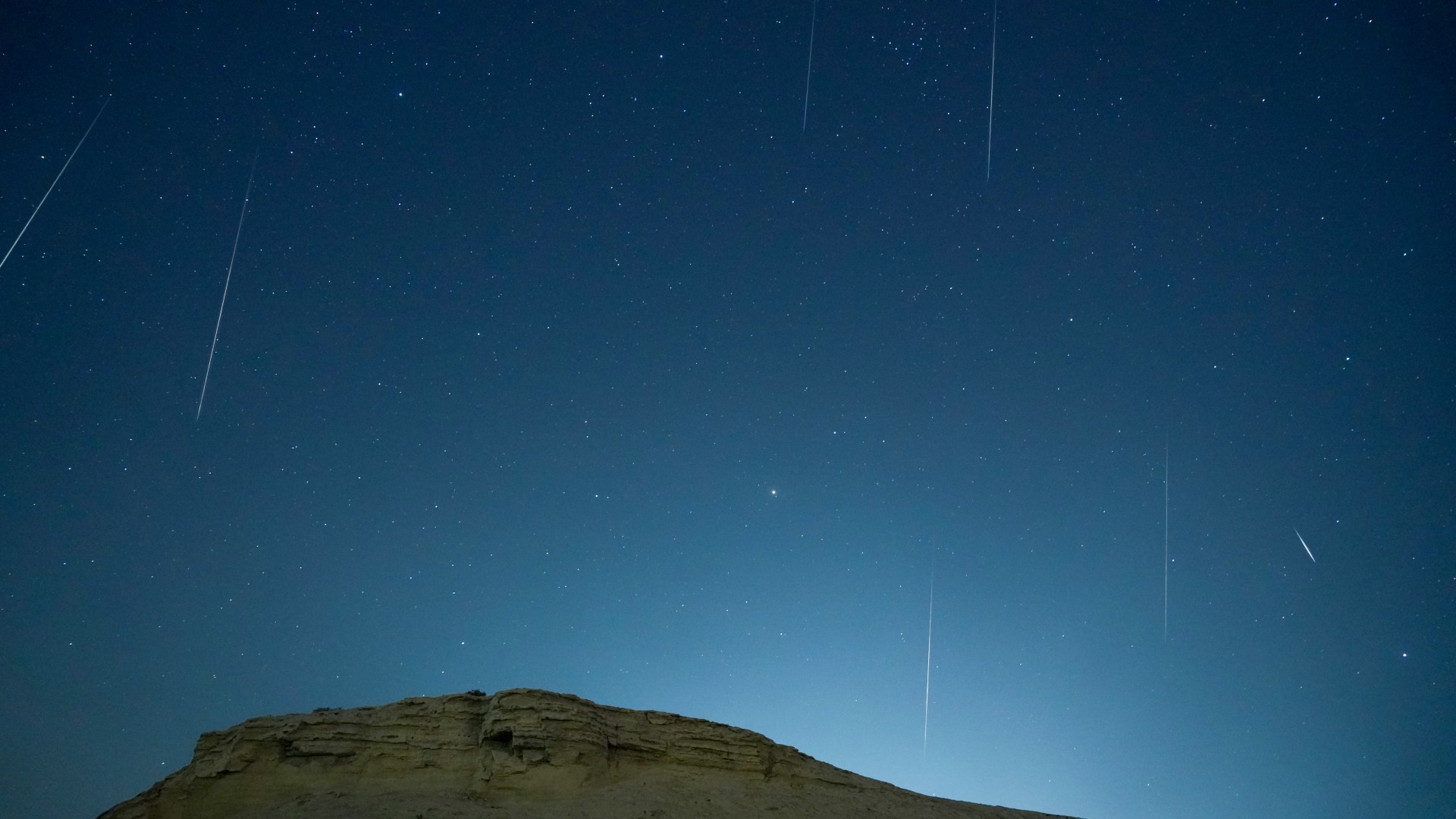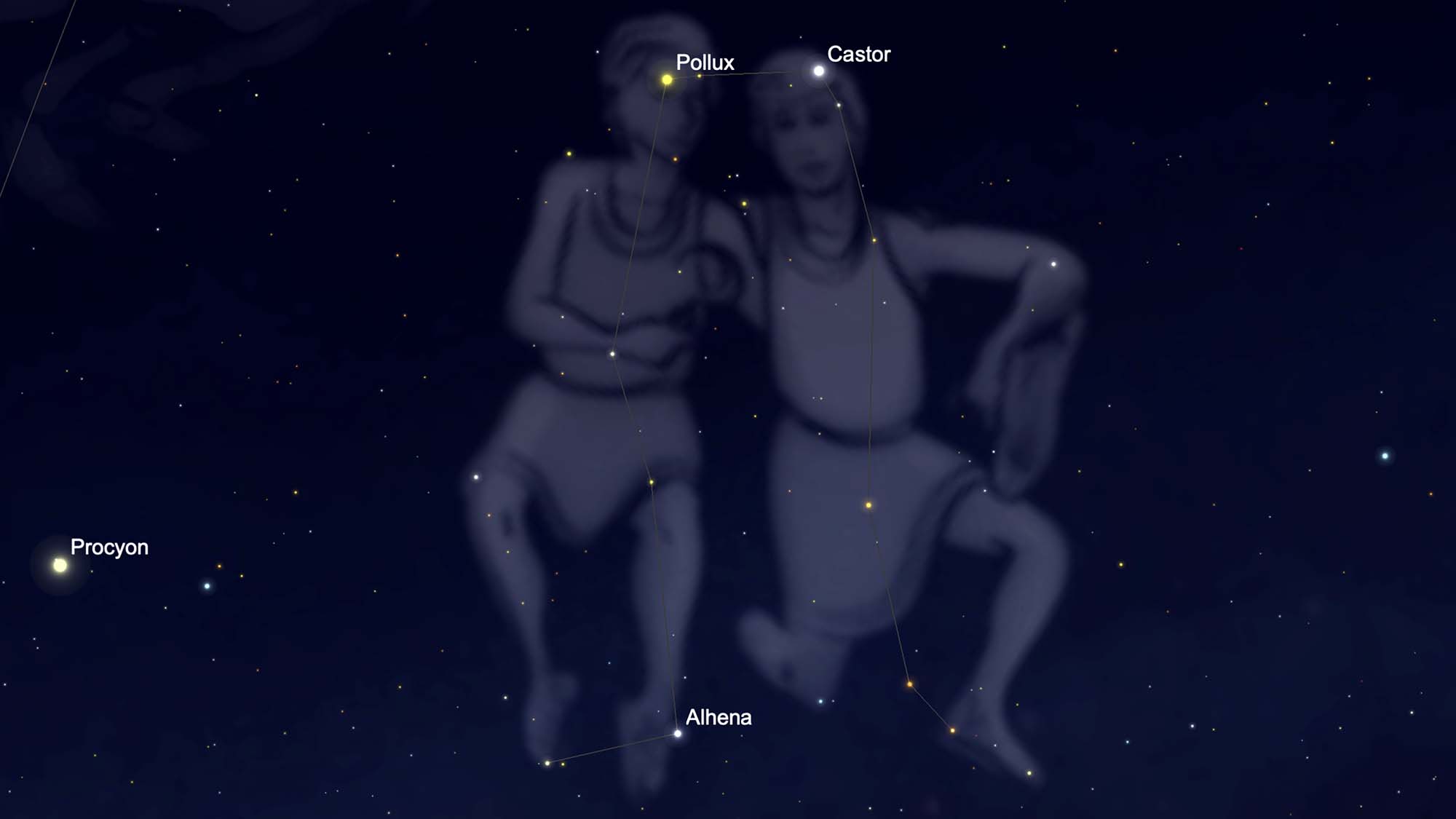
What potentially will be the best meteor display of the year is just around the corner, scheduled to reach its peak on late Wednesday night/early Thursday morning, Dec. 13-14: The Geminid meteor shower.
If you were disappointed with the meager showing put on by last month's Leonid meteor shower, don't fret. The Geminid meteors are usually the most satisfying of all the annual showers, even surpassing the famous Perseids of August. Studies of past displays show that this shower has a reputation for being rich both in slow, bright, graceful meteors and fireballs as well as faint meteors, with relatively fewer objects of medium brightness. Geminids typically encounter Earth at 22 miles (35 km) per second; roughly half the speed of a Leonid meteor. Many appear yellowish in hue. Some have even been seen to form jagged or divided paths.
The Geminids get their name from the constellation of Gemini, the Twins. On the night of this shower's maximum — the meteors will appear to emanate from a spot in the sky near the bright star Castor in Gemini.
The Earth moves quickly through this meteor stream producing a somewhat broad, lopsided activity profile. Rates increase steadily for two or three days before maximum, reaching roughly above a quarter of its peak strength, then drop off more sharply afterward. Late Geminids, however, tend to be especially bright. Renegade forerunners might be seen for a week or more before maximum, but three nights after peak activity, the Geminids are all but gone for another year.
Related: Meteor showers 2023: When is the next one?
Excellent conditions in 2023

Look at awesome stuff in the night sky up close! We recommend the Celestron Astro Fi 102 as the top pick in our best beginner's telescope guide.
The Geminids perform excellently in any year, but 2023 can be categorized as a "superb year." Last year's display in contrast, was seriously compromised by bright moonlight when a bright gibbous moon came up over the horizon during the late evening hours and washed-out many of the fainter Geminid streaks with its bright light.
But this year, the moon will be at new phase on Dec. 12. On the peak night, the moon will be a skinny crescent, low in the west-southwest at dusk and setting around 5 p.m. on Wednesday evening. That means that the sky will be dark and moonless for the balance of the night, making for perfect viewing conditions for the shower.
Get the Space.com Newsletter
Breaking space news, the latest updates on rocket launches, skywatching events and more!
According to Margearet Campbell-Brown and Peter Brown in the 2023 Observer's Handbook of the Royal Astronomical Society of Canada, the Geminids are predicted to reach peak activity at 2 p.m. EDT (1900 GMT). That means those places from eastern Europe and northeast Africa east to central Russian and Chinese longitudes are in the best position to catch the very crest of the shower, when the rates conceivably could exceed 120 per hour! But maximum rates persist at only marginally reduced levels for some 6 to 10 hours around the biggest ones, so other places (such as North America) should enjoy some fine Geminid activity as well.
Indeed, under normal conditions on the night of maximum activity, with ideal dark-sky conditions, at least 60 or more Geminid meteors can be expected to burst across the sky every hour on the average (Light pollution greatly cuts the numbers).
Best views after 10 p.m.
Generally speaking, depending on your location, Gemini begins to come up above the east-northeast horizon right around the time evening twilight is coming to an end. So, you might catch sight of a few early Geminids as soon as the sky gets dark. There is also a fair chance of perhaps catching sight of some "Earth-grazing" meteors. Earth grazers are long, bright shooting stars that streak overhead from a point near to even just below the horizon. Such meteors are so distinctive because they follow long paths nearly parallel to our atmosphere.
The Geminids begin to appear noticeably more numerous in the hours after 10 p.m. local time, because the shower's radiant is already fairly high in the eastern sky by then. The best views, however, come around 2 a.m., when their radiant point will be passing very nearly overhead. The higher a shower's radiant, the more meteors it produces all over the sky.

Bundle up!
But keep this in mind: At this time of year, meteor watching can be a long, cold business. You wait and you wait for meteors to appear. When they don't appear right away, and if you're cold and uncomfortable, you're not going to be looking for meteors for very long!
A night in a sleeping bag under the stars is an attractive proposition in summer, and as a consequence, many vacation campers independently "discover" the August Perseids. But it's a whole different story for the Geminids, which require lying on the ground or a long lawn chair in December for several hours after midnight, looking up at a clear sky that has brought radiational cooling and plummeting temperatures since sunset.
The late Henry Neely (1879-1963), who for many years served as a popular lecturer at New York's Hayden Planetarium, once had this to say about watching for the Geminids: "Take the advice of a man whose teeth have chattered on many a winter's night — wrap up much more warmly than you think is necessary."
Hot cocoa or coffee can take the edge off the chill, as well as provide a slight stimulus. It's even better if you can observe with friends. That way, you can keep each other awake, as well as cover more sky. Give your eyes time to dark-adapt before starting.
Progenitor is an asteroid
Geminids stand apart from the other meteor showers in that they seem to have been spawned not by a comet, but by 3200 Phaëthon, an active Earth-crossing Apollo asteroid with an orbit that brings it closer to the sun than any other named asteroid. For this reason, it was named after the Greek myth of Phaëthon, son of the sun god Helios.
Then again, the Geminids might be comet debris after all, for some astronomers consider Phaëthon to really be the dead nucleus of a burned-out comet that somehow got trapped into an unusually tight orbit.
If you want to try your hand at photographing the Geminids or any other meteor shower, be sure to check out our how to photograph meteors and meteor showers guide. And if you need imaging gear, consider our best cameras for astrophotography and best lenses for astrophotography.
Editor's note: If you snap a great photo of the Geminid meteor shower that you'd like to share with Space.com and our news partners for a story or image gallery, send images and comments to spacephotos@space.com.
Joe Rao serves as an instructor and guest lecturer at New York's Hayden Planetarium. He writes about astronomy for Natural History magazine, the Farmers' Almanac and other publications.
Join our Space Forums to keep talking space on the latest missions, night sky and more! And if you have a news tip, correction or comment, let us know at: community@space.com.

Joe Rao is Space.com's skywatching columnist, as well as a veteran meteorologist and eclipse chaser who also serves as an instructor and guest lecturer at New York's Hayden Planetarium. He writes about astronomy for Natural History magazine, Sky & Telescope and other publications. Joe is an 8-time Emmy-nominated meteorologist who served the Putnam Valley region of New York for over 21 years. You can find him on Twitter and YouTube tracking lunar and solar eclipses, meteor showers and more. To find out Joe's latest project, visit him on Twitter.









